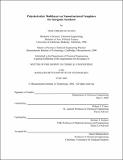| dc.contributor.advisor | Robert E. Cohen. | en_US |
| dc.contributor.author | Wang, Tom Chih-Hung, 1973- | en_US |
| dc.contributor.other | Massachusetts Institute of Technology. Dept. of Chemical Engineering. | en_US |
| dc.date.accessioned | 2005-05-19T14:44:12Z | |
| dc.date.available | 2005-05-19T14:44:12Z | |
| dc.date.copyright | 2002 | en_US |
| dc.date.issued | 2002 | en_US |
| dc.identifier.uri | http://hdl.handle.net/1721.1/16822 | |
| dc.description | Thesis (Ph.D.)--Massachusetts Institute of Technology, Dept. of Chemical Engineering, 2002. | en_US |
| dc.description | Includes bibliographical references. | en_US |
| dc.description | This electronic version was submitted by the student author. The certified thesis is available in the Institute Archives and Special Collections. | en_US |
| dc.description.abstract | Thin film nanocomposites consisting of inorganic matter embedded within a soft polymeric matrix on the nanometer length scale are an important class of materials with potential application in optoelectronics and photonics, magnetic media, and batteries and fuel cells. In addition to the component material properties, the properties and performance of the nanocomposite depend crucially on the interaction between and the nanoscale organization of the components. The polymeric matrix plays a critical role in controlling and mediating this interaction and organization. Polyelectrolyte multilayers formed by the layer-by-layer electrostatic assembly of oppositely charged polymers are a versatile new form of thin film in which the physical and chemical architecture can be precisely controlled over the nanoscale. This thesis addresses the elucidation, development, and application of polyelectrolyte multilayers as nanostructured matrices for inorganic synthesis. Multilayers formed from poly(allylamine hydrochloride) (PAH) and poly(acrylic acid) (PAA), possessing ion-exchangeable carboxylic acid groups, were used to bind metal cations within the film. Metallic and semiconducting nanoparticles, including Ag, Pd, and ZnS, were formed in situ by reduction or sulfidation of the bound metal cations. The size and concentration of Ag nanoparticles were controlled by the concentration of metal-binding carboxylic acid groups as determined by multilayer assembly pH. In addition, the metal cation exchange and reaction methodology could be repeatedly cycled to increase nanoparticle size and concentration. An alternative method to increase nanoparticle size was also developed using electroless metal deposition on catalytic Pd particles. | en_US |
| dc.description.abstract | (cont.) The nanoparticles were homogeneously dispersed and randomly distributed within the film due to the high degree of interpenetration between PAH and PAA chains in the multilayer. Stratified films were prepared by assembling fully ionized polyelectrolyte pairs with PAH/PAA during multilayer formation; the nanoparticles were spatially selective for only the PAH/PAA regions. One effect of the embedded Ag nanoparticles was the dramatic enhancement of the nanocomposite refractive index. The ability to control both multilayer architecture and nanoparticle properties via assembly conditions facilitated the controlled modulation of the nanocomposite refractive index over the entire film thickness. Photonic bandgap structures based on stratified polyelectrolyte multilayer nanocomposites were demonstrated. | en_US |
| dc.description.statementofresponsibility | by Tom Chih-Hung Wang. | en_US |
| dc.format.extent | 145 p. | en_US |
| dc.format.extent | 30421769 bytes | |
| dc.format.extent | 30421520 bytes | |
| dc.format.mimetype | application/pdf | |
| dc.format.mimetype | application/pdf | |
| dc.language.iso | eng | en_US |
| dc.publisher | Massachusetts Institute of Technology | en_US |
| dc.rights | M.I.T. theses are protected by copyright. They may be viewed from this source for any purpose, but reproduction or distribution in any format is prohibited without written permission. See provided URL for inquiries about permission. | en_US |
| dc.rights.uri | http://dspace.mit.edu/handle/1721.1/7582 | |
| dc.subject | Chemical Engineering. | en_US |
| dc.title | Polyelectrolyte multilayers as nanostructured templates for inorganic synthesis | en_US |
| dc.type | Thesis | en_US |
| dc.description.degree | Ph.D. | en_US |
| dc.contributor.department | Massachusetts Institute of Technology. Department of Chemical Engineering | |
| dc.identifier.oclc | 50763464 | en_US |
